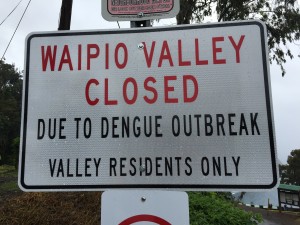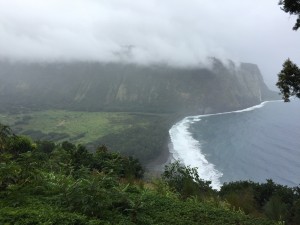As mentioned in the previous post, I fled the mainland for a week to escape Super Bowl madness in the SF Bay Area to the lovely Big Island of Hawaii. As my Lovely Assistant had never been to that island before, we split our time between Hilo and Kailua so she could experience both sides. Given my druthers, I will happily spend any and all time possible in Hilo. It reminds me of Santa Cruz, CA before the 1989 Loma Prieta quake forced the urban renewal that stomped the a lot of the kindness out of the town too. To be fair, I haven’t crunched a syringe underfoot in well over a decade in downtown Santa Cruz but then my desire to go wander around downtown for fun is gone too.
As I read back over this, that’s probably not be the tourism recommendation the Hilo Chamber of Commerce is looking for. It’s a quiet and beautiful town that hasn’t been destroyed by a tsunami in well over 50 years, so high fives. No really, they changed their urban planning in the 1960s to create a flood plain for typical tsunamis (yes, Hawaii gets enough to have “typical” ones) to exhaust themselves in a serene park. To be fair, that park used to be a fishing village separate from Hilo proper, but after the second time you get wiped out within a generation you start reconsidering your real estate development options.
Years ago, I mentioned that I did work as an undergrad that involved pulverizing a lot of volcanic rocks. To be more specific, I was doing isotope geochemistry on volcanic rocks trying to answer an important geological question: Does what goes down come back up? TL;DR answer is yes, but it’s complicated. if you’d like to know more you’re welcome to read this paper, which became someone else’s PhD outlined by my undergrad thesis, that resulted from me playing with a lot powerful acids and reducing rocks to tiny samples that I then vaporized on a mass spectrometer. Trust me, this is actually relevant to coffee.
That fundamental question was tested by looking for something that had a very distinct isotopic mix, subducting under another plate, with a resulting volcanic arc. If you take the Pacific Ocean, away you can see the chain of dead volcanoes extending across the plate from the vicinity of Midway all the way to Izu-Bonin volcanic arc. These are big mountains, the kind that are large enough to deform the oceanic crust around them, which makes big troughs on either side that collect sediments, which are mostly landslides from the seamounts and chert from dead abyssal plankton. The Western Seamounts basalt, when mixed with the chert, makes a quite particular isotopic profile that, funny enough, isotopically looks an awful lot like the volcanic island directly above the where they subduct, AKA the island of Guam. As you move north or south from Guam, that isotopic signal fades away.
Which lead me to an odd thought: hey, Guam is in the Coffee Belt and has the right volcanic soil, I wonder if 100% Guamian coffee tastes close to Kona coffee? The mode of volcanism is different but the chemistry is similar. Or, at the very least, I could answer the question of what would coffee grown on the slopes of the submerged mountains I did my thesis on; Guam is as close as I can get. This, unfortunately, is an academic question as Guamian coffee appears to damn near impossible to get outside of Guam as pure varietal as there is very little under cultivation there anymore.
Speaking of Kona coffee, I drank a great deal of it. I also made a point to sample as much Ka’u, Puna, Hilo and Hamakua coffee as I could get my hands on just to compare the very different flavors from what is, more or less, very similar volcanic soils. In particular, I would like to give appreciation to the work of Hilo Shark’s Coffee, which you can hang out at for hours in downtown Hilo. Their coffee, chocolate, and vanilla is coming from their farm on the Hilo coast up the road a bit. When you order a hot chocolate and the whipped cream is sprinkled with nibs rather than dusted with cocoa powder, that’s a damn good sign. The small bar I bought is some of the best bittersweet dark chocolate I’ve had. While sitting savoring our coffee and cocoa, I remarked to my Lovely Assistant that if they had a tea plantation I might have a hard time getting her to leave. She immediately began searching and found one a few miles away from the Sharky Farm so, umm, if Hilo needs a PhD chemist who’s a also decent programmer I think you’ll have little difficulty convincing her to move there.

There was one unfortunate thing that happened while there which was a fresh outbreak of dengue fever. The Waipio Valley is beautiful but difficult to get to at the best of times, which also makes treatment for re-eradication of disease difficult. Unfortunately, sick visitors and workers regularly bring dengue back to Hawaii and it sets up residence to make a disease reservoir anew in Waipio. I was ambivalent about finding this sign: while I’m glad this sign exists for me to take a picture of for my collection of interesting safety signs, it’s telling that it happens enough that they have this sign ready to go. As a friend who is now responding to this outbreak said, “It could be worse. They didn’t just leave the sign up at the overlook and add an extra sign & lights of WHEN LIGHTS ARE FLASHING.”

But that doesn’t do justice to Waipio. Really, it is gorgeous there. I’ll leave you today with this picture from the overlook.